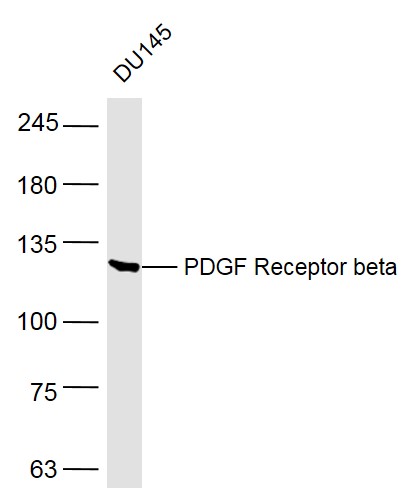![WB analysis of NIH3T3 cell lysate using GTX83371 PDGF Receptor beta antibody [1A2]. WB analysis of NIH3T3 cell lysate using GTX83371 PDGF Receptor beta antibody [1A2].](https://www.genetex.com/upload/website/prouct_img/normal/GTX83371/GTX83371_20170912_WB_w_23061322_862.webp)
WB analysis of NIH3T3 cell lysate using GTX83371 PDGF Receptor beta antibody [1A2].
PDGF Receptor beta antibody [1A2]
GTX83371
ApplicationsWestern Blot, ELISA, ImmunoHistoChemistry, ImmunoHistoChemistry Paraffin
Product group Antibodies
ReactivityHuman, Mouse
TargetPDGFRB
Overview
- SupplierGeneTex
- Product NamePDGF Receptor beta antibody [1A2]
- Delivery Days Customer9
- Application Supplier NoteWB: 1/500 - 1/2000. ELISA: 1/10000. *Optimal dilutions/concentrations should be determined by the researcher.Not tested in other applications.
- ApplicationsWestern Blot, ELISA, ImmunoHistoChemistry, ImmunoHistoChemistry Paraffin
- CertificationResearch Use Only
- ClonalityMonoclonal
- Clone ID1A2
- ConjugateUnconjugated
- Gene ID5159
- Target namePDGFRB
- Target descriptionplatelet derived growth factor receptor beta
- Target synonymsCD140B, IBGC4, IMF1, JTK12, KOGS, OPDKD, PDGFR, PDGFR-1, PDGFR1, PENTT, platelet-derived growth factor receptor beta, Activated tyrosine kinase PDGFRB, CD140 antigen-like family member B, NDEL1-PDGFRB, PDGF-R-beta, PDGFR-beta, beta-type platelet-derived growth factor receptor, platelet-derived growth factor receptor 1, platelet-derived growth factor receptor, beta polypeptide
- HostMouse
- IsotypeIgG1
- Protein IDP09619
- Protein NamePlatelet-derived growth factor receptor beta
- Scientific DescriptionThis gene encodes a cell surface tyrosine kinase receptor for members of the platelet-derived growth factor family. These growth factors are mitogens for cells of mesenchymal origin. The identity of the growth factor bound to a receptor monomer determines whether the functional receptor is a homodimer or a heterodimer, composed of both platelet-derived growth factor receptor alpha and beta polypeptides. This gene is flanked on chromosome 5 by the genes for granulocyte-macrophage colony-stimulating factor and macrophage-colony stimulating factor receptor; all three genes may be implicated in the 5-q syndrome. A translocation between chromosomes 5 and 12, that fuses this gene to that of the translocation, ETV6, leukemia gene, results in chronic myeloproliferative disorder with eosinophilia. [provided by RefSeq, Jul 2008]
- ReactivityHuman, Mouse
- Storage Instruction-20°C or -80°C,2°C to 8°C
- UNSPSC12352203
References
- Ono Y, Nagai M, Yoshino O, et al. CD11c+ M1-like macrophages (MΦs) but not CD206+ M2-like MΦ are involved in folliculogenesis in mice ovary. Sci Rep. 2018,8(1):8171. doi: 10.1038/s41598-018-25837-3Read this paper






![ICC/IF analysis of NIH-3T3 cells using GTX00798 PDGF Receptor beta antibody [GT1140]. Red: Primary antibody Blue: DAPI](https://www.genetex.com/upload/website/prouct_img/normal/GTX00798/GTX00798_20191101_AP_002_35_w_23053121_180.webp)
![FACS analysis of human CD140b / PDGF-RB stable transfectants using GTX80295 PDGF Receptor beta antibody [18A2].](https://www.genetex.com/upload/website/prouct_img/normal/GTX80295/GTX80295_20191028_FACS_1_w_23061322_808.webp)